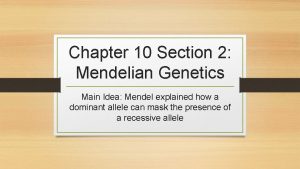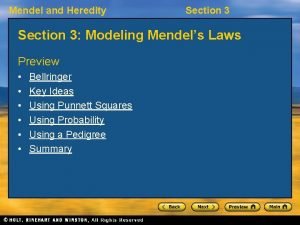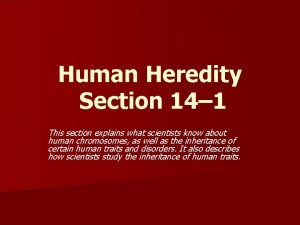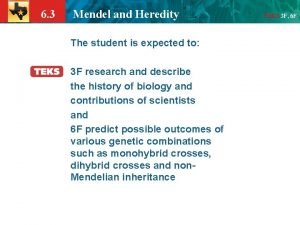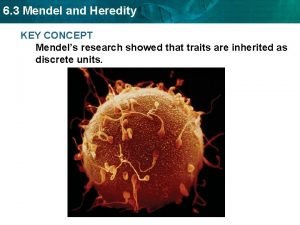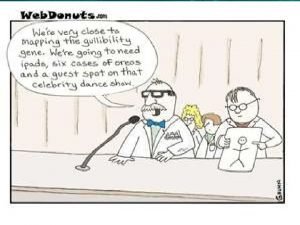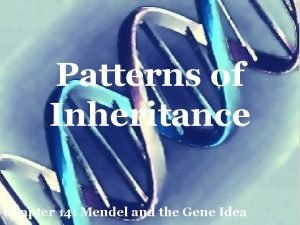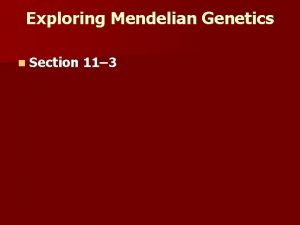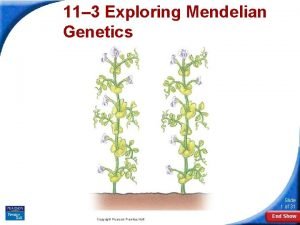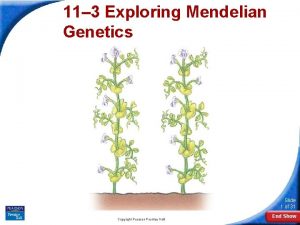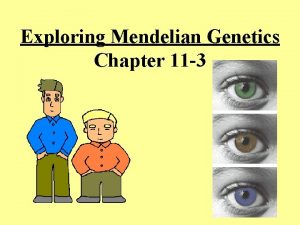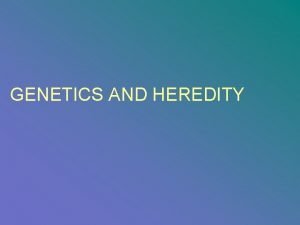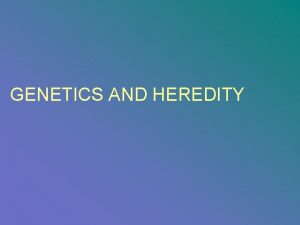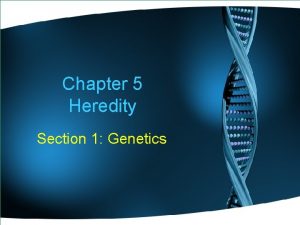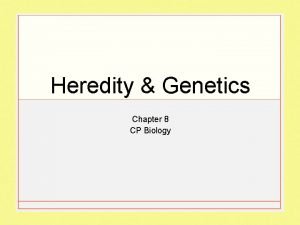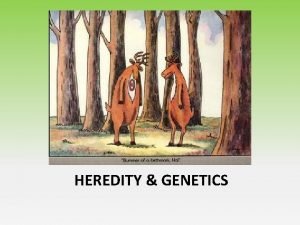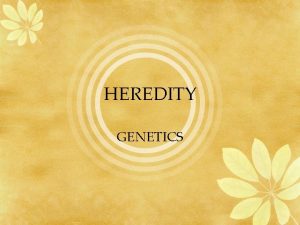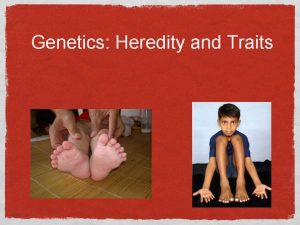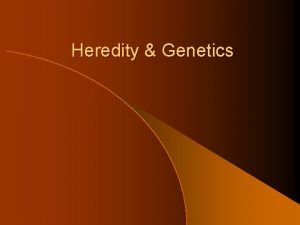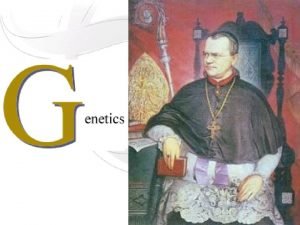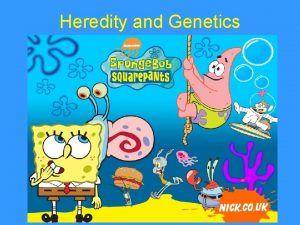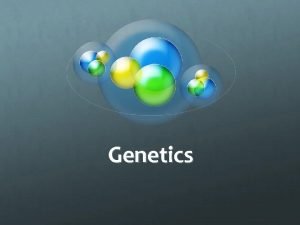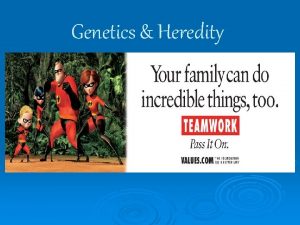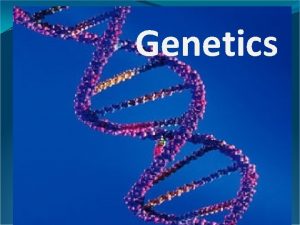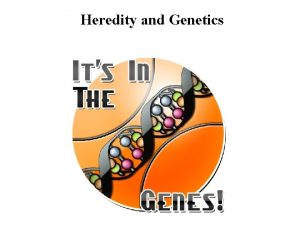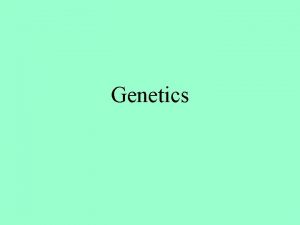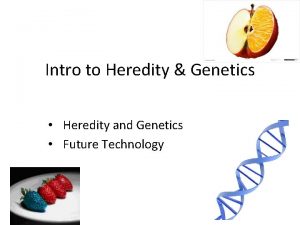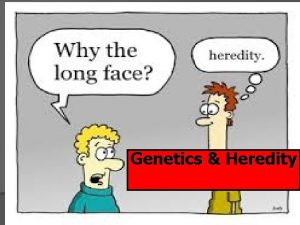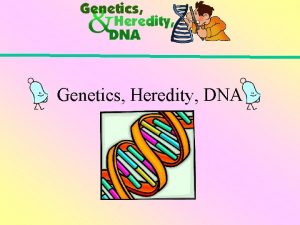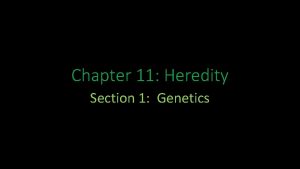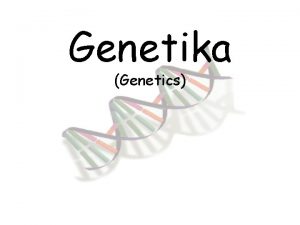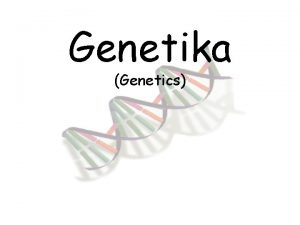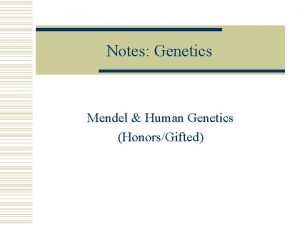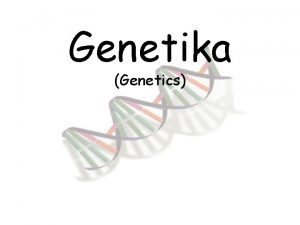Chapter 5 Heredity Section 1 Genetics Heredity the



























- Slides: 27

Chapter 5: Heredity

Section 1: Genetics

—Heredity – the passing of traits from parent to offspring o Genes on chromosomes control the traits that show up in an organism o The different forms of a trait that a gene may have are alleles

o During meiosis a pair of chromosomes separates and the alleles move into separate cells o Each chromosome now contains one gene for each trait o The study of how traits are inherited is genetics

—Gregor Mendel – the father of genetics o Mendel was the first person to use mathematics of probability to explain heredity and to trace one trait for several generations.

o Hybrid – receives different genetic information for a trait from each parent § Dominant allele – covers up or dominates the other trait § Recessive allele – the trait seems to disappear

o Gregor Mendel’s main conclusions § Traits are controlled by alleles on chromosomes § An allele may be dominant or recessive § When a pair of chromosomes separate during meiosis, the alleles move into separate sex cells o Probability helps you predict the chance that something will happen

o A Punnett square can help you predict what an offspring will look like § Upper case letters stand for dominant alleles § Lower case letters stand for recessive alleles

o Genotype – the genetic makeup of an organism § Homoxygous – an organism with two alleles for one trait that are the same (written as two upper case or two lower case letters, ex: TT or tt) § Heterozygous – an organism with two alleles for one trait that are different (written as one upper case and one lower case letter, ex: Tt)

o Phenotype – the way an organism looks and behaves as a result of its genotype

o Making a Punnett Square: § The two alleles from one parent are listed on top of the square, and the two alleles from the other parent are listed on the left side. T T t t

§ To determine the possible genotypes of the offspring fill in the boxes with the alleles above and to the left side of the box T T t t

§ Each box contains a combination of two alleles → one possible genotype T t T TT Tt tt § TT = homozygous dominant § Tt = heterozygous § tt = homozygous recessive • The only option where the recessive phenotype is expressed

Section 2: Genetics Since Mendel

—Incomplete dominance o Neither allele for a trait is dominant o The phenotype produced is intermediate between the two homozygous parents o Ex: experiments with four o’ clock flowers

—Multiple alleles o More than two alleles are multiple alleles o Traits controlled by multiple alleles produce more than three phenotypes o Ex: blood type

—Polygenic inheritance o A group of gene pairs acts together to produce a trait § Creates more variety in phenotypes o Many human traits are controlled by polygenic inheritance § Ex: hair color, eye color

—Mutations – genes that are altered or copied incorrectly o A mutation can be harmful, beneficial, or have no effect. o Chromosome disorders are caused by having more or fewer chromosomes than normal § Down Syndrome is caused by an extra copy of chromosome 21

—Recessive genetic disorders o Both parents have a recessive allele responsible for the disorder and pass it to their child. § The parents are heterozygous and don’t show any symptoms of the disorder § The child with both recessive alleles will show symptoms of the disorder § Cystic fibrosis is a homozygous recessive disorder

—Genes that determine the sex of an organism o Females produce eggs with an X chromosome only o Males produce sperm with either an X chromosome or a Y chromosome o Which chromosomes combine determines the sex of an organism § XX = female § XY = male

—Sex-linked disorders o An allele inherited on an X or Y chromosome is called a sex-linked gene o Color blindness is a sex-linked disorder caused by a recessive allele on the X chromosome

o A pedigree follows a trait through generations of a family § Circles represent females § Squares represent males § A completely filled shape shows that the trait is seen in that person § A half filled shape indicates a heterozygous carrier that does not exhibit the trait § An empty shape shows people that do not have the trait and are not carriers o A pedigree helps geneticists predict the probability that a baby will be born with a specific trait


Section 3: Advances in Genetics

—Genetic engineering – changing the arrangement of DNA that makes up a gene o Recombinant DNA § Insertion of a useful segment of DNA into a bacterium § An example is insulin

o Gene therapy § A normal allele is placed into a virus, which delivers the normal allele when it infects its target cell § May be used to control cystic fibrosis or other genetic disorders

—Genetically engineered plants are created by inserting the gene that produce desired traits in one plant into a different plant o Can be used to improve insect resistance or drought resistance o Desired traits may change ripening times, habitats, or growing seasons
 Chapter 17 the beginning of the life cycle
Chapter 17 the beginning of the life cycle Genetics is the study of heredity and variation
Genetics is the study of heredity and variation Chapter 11 human heredity section 11-3
Chapter 11 human heredity section 11-3 Chapter 12 section 1 molecular genetics answer key
Chapter 12 section 1 molecular genetics answer key Chapter 12 section 1 dna the genetic material
Chapter 12 section 1 dna the genetic material Chapter 10 section 2 mendelian genetics answer key
Chapter 10 section 2 mendelian genetics answer key Section 3 mendel and heredity
Section 3 mendel and heredity Section 14-1 human heredity
Section 14-1 human heredity Section 3 mendel and heredity
Section 3 mendel and heredity Section 3 mendel and heredity
Section 3 mendel and heredity Section 3 mendel and heredity
Section 3 mendel and heredity Section 3 mendel and heredity
Section 3 mendel and heredity Chapter 11 complex inheritance and human heredity test
Chapter 11 complex inheritance and human heredity test Chapter 14 human heredity
Chapter 14 human heredity Chapter 14 patterns of heredity
Chapter 14 patterns of heredity Section 1 meiosis
Section 1 meiosis Section 11-5 linkage and gene maps answer key
Section 11-5 linkage and gene maps answer key 14-3 human molecular genetics answer key
14-3 human molecular genetics answer key Section 11-3 exploring mendelian genetics
Section 11-3 exploring mendelian genetics Sexual reproduction and genetics section 1 meiosis
Sexual reproduction and genetics section 1 meiosis Section 11-3 exploring mendelian genetics answers
Section 11-3 exploring mendelian genetics answers 11.3 exploring mendelian genetics
11.3 exploring mendelian genetics Section 11-3 exploring mendelian genetics answer key
Section 11-3 exploring mendelian genetics answer key Molecular genetics section 1 dna the genetic material
Molecular genetics section 1 dna the genetic material Chapter 10 sexual reproduction and genetics
Chapter 10 sexual reproduction and genetics Extending mendelian genetics
Extending mendelian genetics Chapter 22 genetics and genetically linked diseases
Chapter 22 genetics and genetically linked diseases Section 1 chromosomes and phenotype study guide a
Section 1 chromosomes and phenotype study guide a





